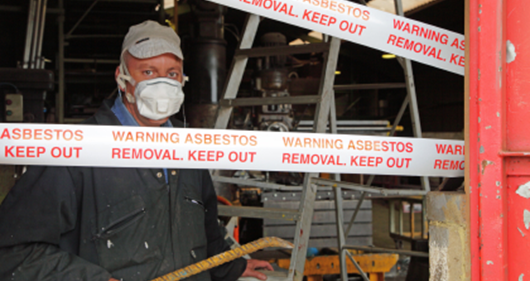
Health effects of asbestos exposure:
- Asbestosis – a serious, progressive, long-term non-cancer disease of the lungs. It is caused by inhaling asbestos fibers that irritate lung tissues and cause the tissues to scar. The scarring makes it hard for oxygen to get into the blood. Symptoms of asbestosis include shortness of breath and a dry, crackling sound in the lungs while inhaling. There is no effective treatment for asbestosis.
- Lung cancer – causes the largest number of deaths related to asbestos exposure. The most common symptoms of lung cancer are coughing and a change in breathing. Other symptoms include shortness of breath, persistent chest pains, hoarseness, and anemia. People who have been exposed to asbestos and also are exposed to some other cancer-causing product, such as cigarette smoke, have a greater risk of developing lung cancer than people who have only been exposed to asbestos.
- Mesothelioma – is a rare form of cancer that is found in the thin lining (membrane) of the lung, chest, abdomen, and heart and almost all cases are linked to exposure to asbestos. This disease may not show up until many years after asbestos exposure.
Occupations with the highest risk for workers exposed to asbestos fibers:
- Construction workers handling or installing insulation.
- Miners
- Auto Mechanics
- Roofers
- Factory Workers
- Electricians
- Ship builders
- Railroad workers
- Gas mask manufacturers
- Demolition workers
- Drywall removers
- Asbestos removal workers
- Firefighters
Family members of workers heavily exposed to asbestos face exposure to asbestos fibers brought into the home on the shoes, clothing, skin and hair are also at risk of contracting asbestos-related diseases. This type of “second-hand” exposure to asbestos is known as para-occupational exposure.
To prevent asbestosis:
- Wear a protective mask or air supplied hood when working around asbestos. Due to government regulations now in place, asbestos is no longer used in building construction. However, older buildings often do contain this harmful insulator so take precautions when remodeling or demolishing older buildings.
- Follow recommended industrial procedures to prevent exposure to harmful dust during asbestos removal. Some of these methods involve wetting down surfaces with water and covering asbestos loads with various materials to prevent fibers from entering the air.
- Engage in regular exercise designed to strengthen your cardiopulmonary system. Keeping your heart and lungs healthy and strong will help them ward off damage.
- Don’t smoke and avoid secondhand smoke whenever possible. Smoking causes similar damage to your lungs as asbestos exposure does, so if you smoke you could be giving your lungs a double dose of poisoning.
- Schedule regular x-rays if you work in asbestos-related industries. They can detect shadows on the lungs that could be an early sign of asbestosis.
For more information, please see the following related page on our website:
Mesothelioma Lawsuits

 855-722-2552
855-722-2552